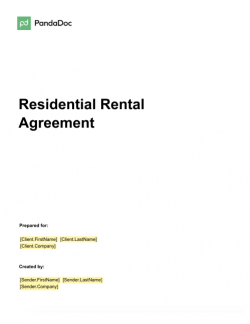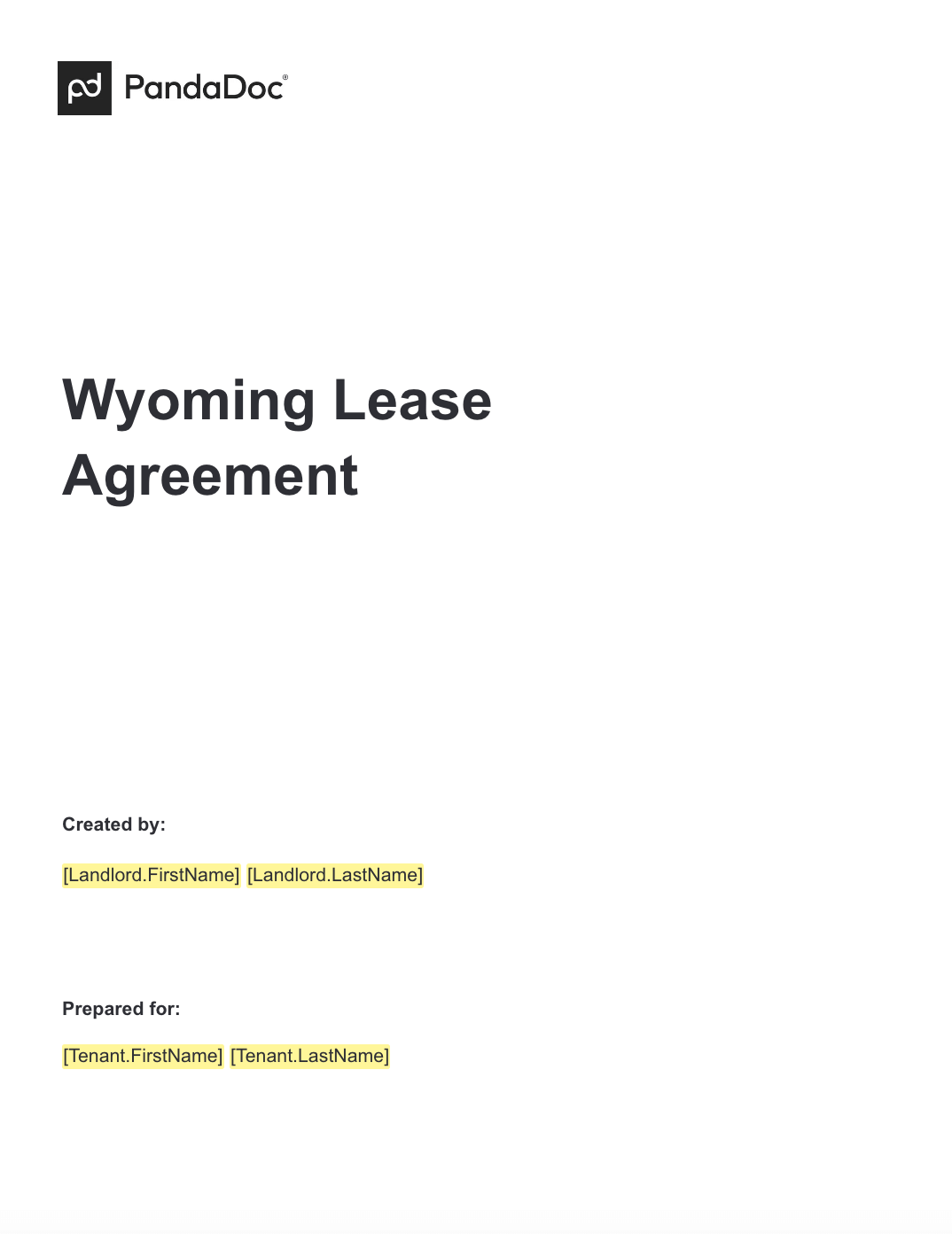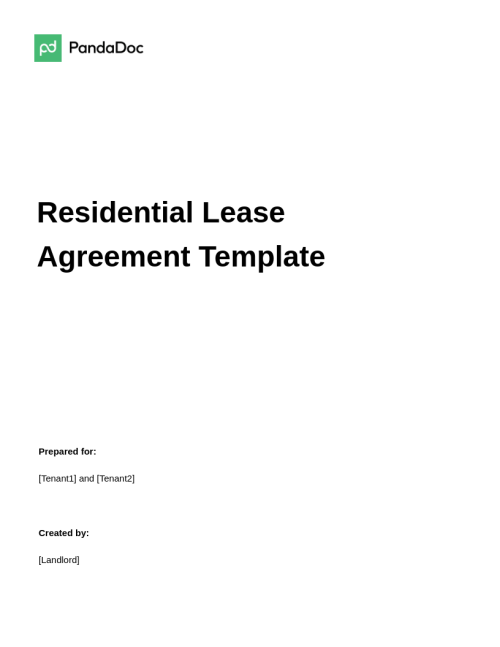Key Takeaways
- Lease agreements outline the key terms of a property rental or lease in Wyoming.
- These agreements vary depending on the type of lease, its duration, and the property involved, each with its legal considerations.
- Predefined templates provide a convenient framework that caters to your leasing situation, eliminating the need for extensive modifications.
- Selecting a template tailored to Wyoming’s laws ensures clear understanding and legal safeguarding for both landlords and tenants within the state.
- PandaDoc offers legitimate and legal protection by providing free comprehensive Wyoming Lease Agreement Templates.
Wyoming Lease Agreement Templates
Residential Lease Agreement

Residential Rental Agreement
Used 5,261 times
Save time and resources by using this customizable residential rental agreement to create legally binding contracts with your tenants. It includes detailed sections about all aspects of a typical tenancy, including terms, responsibilities, rent, duration, insurance, maintenance, and more.
This agreement serves as a formal contract between landlords and tenants renting residential properties in Wyoming
Wyoming Apartment Lease
Specifically designed for apartment rentals in Wyoming, this lease agreement outlines the terms and conditions governing the leasing of an apartment unit, including rent, utilities, and maintenance responsibilities.
Wyoming Room Rental
Tailored for renting individual rooms within a property, this template helps landlords and tenants establish clear guidelines for shared living spaces.
Wyoming Month-to-Month Lease
Offering flexibility without the long-term commitment, this lease agreement allows for short-term rental arrangements in Wyoming, providing both landlords and tenants with the freedom to adjust rental terms as needed.
Commercial Lease Agreement
This agreement is crafted for leasing commercial properties in Wyoming, covering essential aspects such as lease terms, rent adjustments, and property use restrictions.
Lease to Purchase Agreement
Providing a structured framework for lease-to-own arrangements, this agreement offers tenants in Wyoming the option to purchase the property in the future.
Sublease Agreement
Facilitating subleasing arrangements, this agreement ensures clarity and professionalism between the original tenant and the subtenant.
Understanding Wyoming Rental Laws
In Wyoming, a lease agreement is automatically established when a property is rented, and it inherently includes certain rights and obligations. According to Wyoming Statutes (Title 1 Chapter 21: Article 12 – Residential Rental Property), tenants are entitled to live in a habitable residence and are protected against housing discrimination. Conversely, landlords have the privilege of receiving punctual rent payments and the authority to evict if the lease terms are breached.
| Laws | Name | Description |
| § 1-21-1202 | Duties of owners and renters; generally | It encompasses key components like the proposal and its acceptance, the exchange of value, and the ability of the involved parties to form contracts. |
| § 1-21-1203 | Owner’s duties; notice by renter of noncompliance; duty to correct; exceptions; termination of rental agreement; liability limited | It details the privileges and duties of both landlords and tenants, encompassing aspects like the payment of rent, upkeep of the property, and the tenant’s entitlement to undisturbed use of the premises. |
| § 1-21-1208 | Deductions from deposit; written itemization; time limits; failure to give notice; recovery by renter; utilities deposit; penalty | It governs the gathering, managing, and refunding of security deposits, including stipulations on the maximum permissible amounts and detailed deductions. |
| § 1-21-1206 | Renter’s remedies; notice to owner or agent; judicial remedy; rights under termination of rental agreement | It sends owners and renters the necessary notifications to end lease contracts. |
| § 1-21-1211 | Owner’s remedies; eviction; judicial remedies; damages | It lays out the lawful steps for evictions, which include the methods for delivering notices and initiating actions for unlawful possession. |
Security Deposit limits
In Wyoming, the following items can be deducted from security deposits:
- Unpaid rent
- Damage costs, excluding normal wear and tear
- Other charges, as specified in the lease
- Cleaning expenses
Like most other states, Wyoming doesn’t have a legal limit on the amount that landlords can charge for security deposit damages as long as the charges are considered reasonable.
Suppose the damage costs surpass the security deposit. In that case, landlords can claim additional damages from the former tenant and an annual interest of 10%.
If the rental unit isn’t physically damaged, Wyoming landlords have either 15 or 30 days to return any remaining part of the security deposit, whichever is later:
- After the tenant provides a forwarding address, 15 days shall be observed.
- 30 days after the lease term ends
If the rental unit is damaged, the timeframe extends by 30 days. Therefore, landlords have either 45 or 60 days to return any remaining part of the security deposit after making deductions, whichever is later:
- 45 days after the tenant provides a forwarding address
- 60 days after the lease term ends
Tenants must provide a forwarding address up to (30) days after the lease term ends.
Eviction Procedures
It’s not allowed for a landlord to evict a tenant unless there’s a valid reason. The legal reasons for eviction encompass:
- Failure to pay rent punctually
- Occupying the property beyond the lease term
- Breaching the lease conditions
The landlord must provide appropriate notice based on the eviction grounds and offer the tenant an opportunity to rectify the violation.
Here are the grounds for eviction, the notice period, and whether the violation is curable:
- Nonpayment of Rent: 3 Days Notice
- End of Lease or No Lease: 30 Days Notice
- Lease Violation: 3 Days Notice
Right to Enter (Landlord)
Landlords typically have the legal right to access a rented property for valid reasons without seeking the tenant’s consent. However, if the tenant has a specific and reasonable ground to require permission, the landlord must obtain it before entering.
It’s legally permitted to access a rented property for these reasons:
- Carrying out maintenance tasks
- Conducting property inspections
- Showcasing the property for potential renters or buyers
Disclosures
- Non-Refundable Fees: Applicable to units that charge non-refundable fees
- Lead Paint: Applicable to all units constructed before 1978
Here are some optional disclosures and their purposes:
- Asbestos: Alerts tenants to any potential asbestos risks associated with the property. Tenants can mitigate these risks by avoiding any disruption of asbestos fibers.
- Bed Bugs: Notify tenants if the property or a neighboring unit has a history of suspected bed bug infestations and remind them of their duty to report any alleged infestations promptly.
- Fees: This section details any late or returned check fees associated with the lease. There are no restrictions on late payments in Wyoming, but returned check fees are capped at $30.
- Landlord’s Name and Address: Provides the landlord’s or authorized agent’s name and address, facilitating the smooth delivery of essential legal notices.
- Medical Marijuana Use: Informs tenants about the property’s policy regarding medical marijuana use. Some state laws permit landlords to limit marijuana use to non-smoking methods only or to allow use solely in designated smoking areas.
- Mold Disclosure: Informs tenants about any known or suspected mold contamination on the property and any remediation efforts to help limit landlord liability.
- Move-In Checklist: A move-in checklist records the current state of the property and any existing damages, enabling accurate deductions upon move-out.
- Shared Utility Arrangements: This section discloses how charges are allocated to individual tenants when multiple rental units share a utility meter for the entire building or property.
- Smoking: Informs tenants of designated smoking areas that don’t disturb other tenants’ quiet enjoyment of the property.



